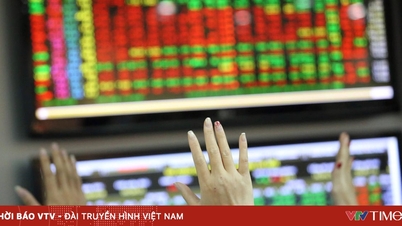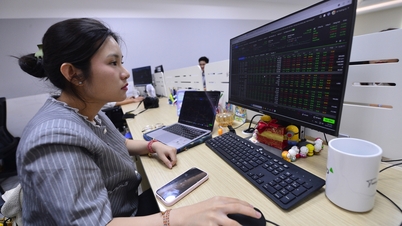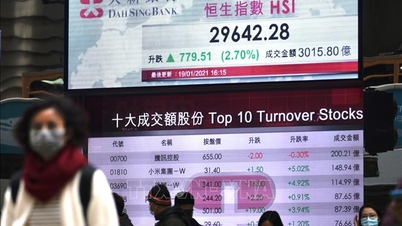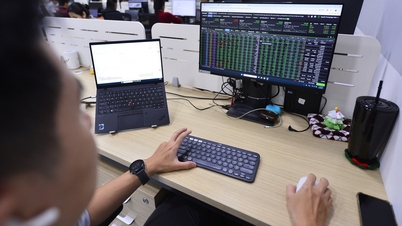
The representative index of Vietnam's stock market is being strongly "pulled" by pillar stocks - Photo: AI
At the end of the session on July 11, VN-Index increased by 12 points, reaching 1,457.76 points, while VN30 broke its historical peak at 1,594 points after doubling the increase of the general market.
Many securities companies and international organizations are optimistically raising their forecast for the Vietnamese stock market index to exceed 1,600 points.
Stocks may surpass 1,663 points
In a recently released report, Vietcombank Securities (VCBS) said that Vietnam is one of the first countries to announce a trade agreement with the US. This shows Vietnam's initiative and flexibility in its foreign and trade strategies.
Although there is still a need for further clarification on transit products, as well as more time to update the US tax rates applied to other countries for comparison and a comprehensive perspective, VCBS said that the current tariff information still brings optimism to the stock market.
Accordingly, listed enterprises are expected to continue to adapt, maintain their operational capacity, increase profits and ensure competitiveness with other countries. This is especially important for enterprises exporting essential goods such as textiles, wood, seafood, etc. and industries attracting FDI capital flows.
This indirectly supports financial sectors such as banking, real estate, and securities in terms of avoiding bad debt and circulating capital, according to VCBS's assessment.
According to this securities company, VN-Index is currently valued at the same level as the regional average. VCBS estimates that Vietnam's P/E (valuation) will fluctuate in the range of 13.9x - 15.3x in 2025.
With the base scenario, VCBS forecasts that the VN-Index could reach 1,555 points with P/E reaching 14.6x and market EPS increasing by 12%.
In the optimistic scenario, the index could reach 1,663 points with expectations of market upgrade, strong and drastic policies to boost growth and positive steps from flexible diplomacy .
Previously, JPMorgan - a large financial institution in the world - also raised its assessment of the Vietnamese stock market to "overweight", and at the same time raised its forecast for the VN-Index to a maximum of 1,600 points in an optimistic scenario.
The end of the year usually increases less than the beginning of the year.
According to the SSI Securities analysis team (SSI Research), historical statistics for the period 2010 - 2024 show that the average increase of the index in the second half of the year tends to be lower than the first half of the year.
On average, the VN-Index increased by 1.64% in the second half of the year, significantly lower than the 6.42% increase recorded in the first half of the year.
SSI Research believes that this trend reflects a seasonal decline in market momentum, with some exceptions. For example, in 2017, the market broke out after a period of sideways accumulation (2013-2016) thanks to strong foreign investment, or in the second half of 2020 when the VN-Index recovered strongly after a sharp decline in the first half of the year due to the COVID-19 pandemic.
These exceptions show the importance of macro factors and liquidity dynamics in determining second-half market performance.
For this year, SSI Research forecasts that in July and early August, the market will be under pressure to take profits during the business results announcement season.
In addition, the room for further monetary policy easing is limited in the context of the exchange rate increasing by more than 3% in the first 6 months of the year. At the same time, the impact of tariffs has begun to be more evident, as shown through export figures and third-quarter business results of a number of related industries such as textiles, seafood, and industrial parks.
Expectations of export improvement
SSI Securities still maintains a positive view on the market in the long term with the target of VN-Index reaching 1,500 points by the end of 2025 thanks to key drivers such as a stable macroeconomic foundation and sustainable profit growth prospects.
Major contributing sectors include banking, real estate, raw materials and consumer goods.
The US's 90-day tax deferral also helps Vietnamese businesses boost exports of many products in the second quarter and have more time to prepare to reduce the impact from this market in the following quarters.
Source: https://tuoitre.vn/du-bao-vn-index-co-the-vuot-moc-1-600-diem-2025071120285755.htm


![[Photo] General Secretary To Lam receives Singaporean Ambassador Jaya Ratnam](https://vphoto.vietnam.vn/thumb/1200x675/vietnam/resource/IMAGE/2025/11/03/1762171461424_a1-bnd-5309-9100-jpg.webp)
![[Photo] Fall Fair 2025 and impressive records](https://vphoto.vietnam.vn/thumb/1200x675/vietnam/resource/IMAGE/2025/11/03/1762180761230_ndo_br_tk-hcmt-15-jpg.webp)
![[Photo] Prime Minister Pham Minh Chinh receives the Chairman of the Japan-Vietnam Friendship Association in the Kansai region](https://vphoto.vietnam.vn/thumb/1200x675/vietnam/resource/IMAGE/2025/11/03/1762176259003_ndo_br_dsc-9224-jpg.webp)

![[Photo] Lam Dong: Close-up of illegal lake with broken wall](https://vphoto.vietnam.vn/thumb/1200x675/vietnam/resource/IMAGE/2025/11/03/1762166057849_a5018a8dcbd5478b1ec4-jpg.webp)




































































































Comment (0)